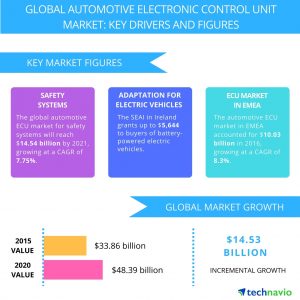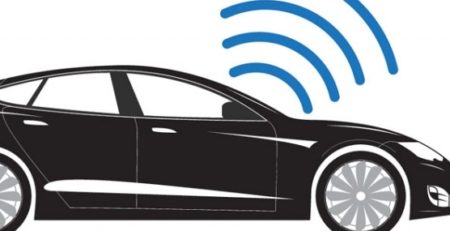Technavio market research analysts forecast the global automotive electronic control unit (ECU) market to grow at a CAGR of more than 7% during 2017-2021, according to their latest report.
According to Siddharth Jaiswal, a lead analyst at Technavio for automotive electronics research, “The quest for automobile safety is considered one of the key drivers for the development of advanced automobile safety systems, which are no longer restricted to premium vehicles. The installation of these automobiles systems requires electronic control units. The number of ECUs is also rising due to the increased demand for infotainment systems and connected vehicles.”

Technavio automotive analysts highlight the following three market drivers that are contributing to the growth of the global automotive ECU market:
Technological push
Technology has grown rapidly in the AUTO ELECTRONICS industry due to the gradual phasing out of mechanical and hydraulic systems, which are being replaced with electronic or hybrid substitutes. The automotive industry is shifting toward autonomous vehicles, which are electronically driven by on-board computers and navigate with the help of the information received from its on-board sensors, connected car network, and the Internet of Things.
The technologies that are gradually pushing vehicular ELECTRONICS toward this goal include drive-by-wire technologies that have been adopted by the aviation industry and hybrid vehicular technology. This, in turn, has increased the number of on-board sensors and ECUs.
Growing demand for driver assistance and other safety systems
In the previous years, advanced driver assistance system (ADASs) were implemented only in premium vehicles due to their high cost. However, OEMs are poised to introduce the system in the mainstream market due to the advances in technology and expansion of ADAS ecology. Moreover, regulatory bodies around the world are also mandating the inclusion of ADAS to improve vehicular safety and reduce automotive accidents.
Most ADASs currently in use are discrete and single function systems that can handle low data throughput. Recent developments in this field have proposed the use of integrated ADAS system-on-chip (SoC), which integrate data from many streams such as vision, ultrasonic, infrared, LiDAR, and RADAR. Therefore, vehicle manufacturers will have increased flexibility and control over their ADAS offerings.
“Adoption of safety features in automobiles will increase the demand for ECUs as they are the crucial components of on-board driver assistance and safety systems,” says Siddharth.
Increased focus of OEMs toward development of autonomous vehicles
The automotive industry is witnessing a structural shift in terms of demand side behavior. Millennials have shifted to models such as carpooling, cab services, and car rentals due to factors such as traffic congestions in cities. OEMs are shifting toward technologies that focus on driverless, autonomous vehicle concepts to adapt to this behavioral change.
Although the autonomous vehicle concept is still in a nascent stage for commercialization, many experts believe that this concept will drive the future of the automotive industry. All major OEMs and tier-1 suppliers have already initiated projects to commercialize this concept of autonomous vehicles. Audi, Ford Motor Company, Continental, Robert Bosch, and Delphi Automotive are the most active players in this space. The demand for automotive ECU will grow considerably as this concept gets commercialized.
Read more at http://telematicswire.net/global-automotive-ecu-market-to-grow-at-a-cagr-of-more-than-7-during-the-period-2017-2021/#do5kg454HZF6y81F.99












